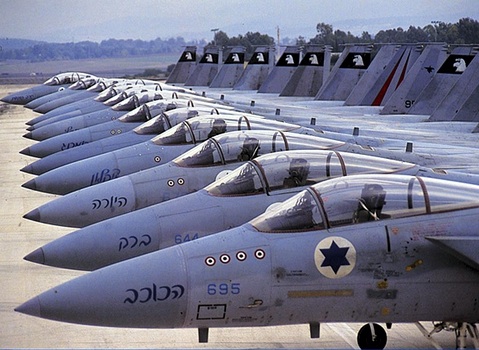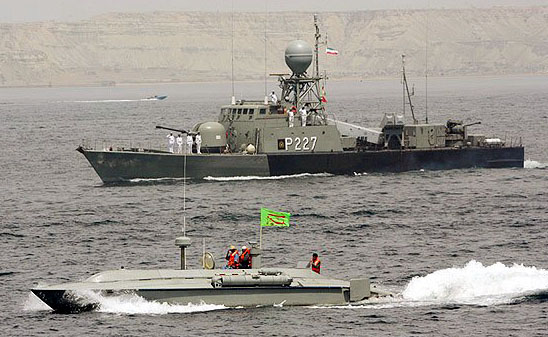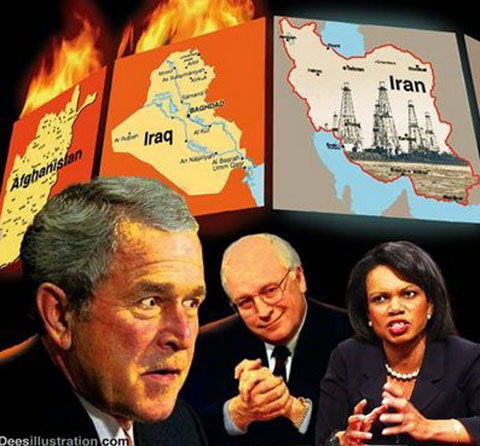www.islandbreath.org ID# 0817-14
SUBJECT: WAR WITH IRAN
SOURCE: DAVID WARD sayjaz3@hotmail.com
POSTED: 12 JULY 2008 - 11:00am EST

image above: American designed F-15 Falcon Israeli Air Force jets
| Israeli jets using US bases in Iraq Israel using Iraq for a likely attack against Iran?
|
SUBJECT: WAR WITH IRAN
SOURCE: DAVID WARD sayjaz3@hotmail.com
POSTED: 7 JUNE 2008 - 9:00am HST
Rumors of War: Is Bush Gearing Up to Attack Iran?

image above: Illustration from 14 September 2007 San Francisco Sentinal
by Conn Hallinan, Portside on 5 June 2008 in www.alternet.org The May 8 letter from U.S. Rep. John Conyers Jr., D-Mich., chair of the House Judiciary Committee, to George W. Bush received virtually no media coverage, in spite of the fact that it warned the president that an attack on Iran without Congressional approval would be grounds for impeachment. Rumor has it several senators have been briefed about the possibility of war with Iran. Something is afoot. Just what is not clear, but over the past several months, several moves by the White House strongly suggest that the Bush administration will attack Iran sometime in the near future. According to the Asia Times, "a former assistant secretary of state still active in the foreign affairs community" said an air attack will target the Iranian Revolutionary Guard Corps (IRGC) Quds Force garrisons. Not even the White House is bonkers enough to put troops on the ground amid 65 million Iranians. There is a certain disconnect to all this, particularly given December's National Intelligence Estimate (NIE) concluding that Iran had abandoned its program to build a nuclear weapon. The NIE is the consensus view of all 16 U.S. intelligence services. At the time, the report seemed to shelve any possibility of war with Iran. However, shortly after the intelligence estimate on Iran was released, the old "into Iraq gang" went to work undermining it. According to Newsweek, during his Middle East tour in January, Bush "all but disowned the document" to Israeli Prime Minister Ehud Olmert. A "senior administration official" told the magazine, "He [Bush] told the Israelis that he can't control what the intelligence community says but that [the NIE's] conclusions don't reflect his own views." Neither do they reflect the views of Vice President Dick Cheney or Defense Secretary Robert Gates. In an interview with ABC during his recent 10-day visit to the region, Cheney downplayed the NIE: "We don't know whether or not they've [the Iranians have] restarted." Cheney also said Iran was seeking to build missiles capable of reaching the United States sometime in the next decade. On April 21, Gates said that Iran was "hell-bent" on acquiring nuclear weapons, and that, while he was not advocating war with Iran, the military option should be kept on the table. A month before Gates' comment, the White House quietly extended an executive order stating that Iran represented an "ongoing threat" to U.S. national security. The Bush administration claims that the 2002 resolution that led to the war in Iraq gives it the right to strike at "terrorists" wherever they are. Last September, the Kyl-Lieberman Sense of the Senate resolution designated the Iranian Revolutionary Guard Corps as a "terrorist organization." The administration has sharply increased its rhetorical attacks on Iran in a way that is disquietingly similar to the campaign that led to the 2003 invasion of Iraq. Take the current charge that the Quds Force is arming anti-American groups in Iraq and providing them with high-tech roadside bombs and sophisticated rockets. Gen. David Petraeus, the new head of U.S. Central Command, told the Senate Committee on Armed Services that "special groups" are "funded, trained, armed and directed by Iran's Quds Force. … It was these groups that launched Iranian rockets and mortar rounds at Iraq's seat of government" in the Green Zone. Patraeus replaced Adm. William "Fox" Fallon, who had openly opposed a military confrontation with Iran. But the United States has never presented any evidence to back up those charges. U.S. officials say the rockets pounding the Green Zone have Iranian markings on them, but they have yet to show any evidence to that effect. And, as for the special roadside bombs, or the explosively formed penetrators (EFP), the evidence is entirely deductive. The United States argues that the copper cores used in these bombs requires using a heavy machine press and that Iraq has no such presses. But before the invasion, Iraq was the most industrialized Arab country, with a sophisticated machine tool industry, and a study by Time magazine says the cities of Basra, Karbala and Najaf "may indeed have such presses." The Time article, "Doubting the Evidence Against Iran," concludes, "No concrete evidence has emerged in public that Iran was behind the weapons [EFPs]. U.S. officials have revealed no captured shipments of such devices and offered no other proof." The lack of evidence has hardly cooled down the rhetoric. Bush said in a speech at the White House that "two of the greatest threats to America" were Iran and al-Qaeda. U.S. preparations for war, however, have been more than rhetorical. According to the Israeli website DEBKAfile, Cheney's trip to the Middle East in March was seen in the region as a possible harbinger of war. "The vice president's choice of capitals for his tour is a pointer to the fact that the military option, off since December, may be on again," DEBKA concluded. "America will need the cooperation of all four [countries he visited] -- Oman, Saudi Arabia, Israel and Turkey." There has also been a steady buildup of naval and air power in the region. A new aircraft carrier battle group has been assigned to the area, Patriot anti-missile missiles have been deployed, and U.S. Naval forces in the Eastern Mediterranean have been beefed up. What would likely happen if the United States did elect to attack? Militarily, there is little Tehran could do in response. Iran's army is smaller than it was during the Iran-Iraq war, and in a recent "show of force," its air force mustered a total of 140 out-of-date fighters. It navy is mostly small craft, and while it has anti-ship missiles, Tehran would probably think twice about trying to shut down the Gulf. The current regime depends on the sale of oil and gas to shore up its fragile economy. While the White House portrays the militias in Iraq and Hezbollah as Tehran's cat's-paw, that is nonsense. The militias in both countries will act on the basis of what is in their own interests, not Iran's. There is talk that Iran might target Israel, but the Israelis have made it clear that any such attack would be met with a massive retaliation, probably nuclear. "An Iranian attack will prompt a severe reaction from Israel," National Infrastructure Minister Binyamin Ben-Eliezer warned, "which would destroy the Iranian nation." In any case, it is far more likely that Israel would attack Iran than vice versa. Any U.S. attack would further isolate the United States in the Middle East. Ethan Chorin, of the conservative Center for Strategic and International Studies, says U.S. threats against Iran are running cross-current to efforts by other nations in the Gulf region to establish a détente with Tehran. "The U.S. seeks to defend the Arabs from Iran, but they are increasingly trying to defend themselves from the U.S. efforts to defend them against Iran," he wrote in a recent commentary in the Financial Times. All the war talk, says Chorin, "is translating into increasing open sympathy on the part of many Gulf Arabs for Iran and increasing skepticism about U.S. efforts to isolate the country." A U.S. war would deeply divide Europe as well, and might lead to a German withdrawal from Afghanistan. What Russia's, China's and India's responses would be is not clear. China and India are major clients for Iranian natural gas. Domestically, the Bush administration may see this as its only opportunity to hold on to the White House. The Republicans know they are going to lose seats in the House and the Senate, but at this point the race for the presidency is still tight. Might a new war against the demonized Iranians make voters stick with "war hero" John McCain? It's a long shot, but this administration has always had a major streak of riverboat gambler about it. All this talk of war, of course, could be sound and fury signifying nothing. But it might also be the run-up to a limited conflict, maybe one set off by a manufactured incident. Once unleashed, however, no one controls the dogs of war. As hard as it is to imagine, war with Iran might top the Iraq War as a foreign policy disaster. Conn Hallinan is a columnist for Foreign Policy in Focus. |
SUBJECT: WAR WITH IRAN
SOURCE: DAVID WARD sayjaz3@hotmail.com
POSTED: 26 APRIL 2008 - 4:00pm HST
US ship fired on Iranian boats

image above: Iranian navy vessels - Sina class P227 Shamshir & North Korean built Submersile PT boat
by John Wilen on 25 April 2008 in biz.yahoo.com Associated Press writers Lolita C. Baldore in Washington, Edward Harris in Lagos, Nigeria, and Gillian Wong in Singapore contributed to this report. |
This “Bent Spear” incident marked the first time in more than 40 years that nuclear weapons had been flown across the continental United States. A spate of up to eight accidental deaths and suicides of personnel from these two bases adds an ominous twist to this story. |
see also:
Island Breath: Petraeus Points to War With Iran 4/14/08
Island Breath: Atack on Iran nears 3/28/08
Island Breath: Bush ready for Iran War 3/1/07
Island Breath: Drumbeat of Iran War 2/11/07
Island Breath: Stop war with Iran 1/20/06
